Featured Exhibits
Sign up for the Newsletter
Advertise on ParachuteHistory.com
Disclaimer
Privacy Policy
About
Cliff Winters
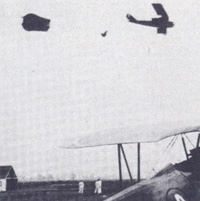 Cliff Winters was one of the CRAZY jumpers in the late 1950's and early 1960's.
Cliff Winters was one of the CRAZY jumpers in the late 1950's and early 1960's.
Winters' jumping career began in the Army with the 82nd Airborne. He also learned to fly under the GI Bill. During this time he was a wing walker and made bat-man jumps for a flying circus. Winters' became a stunt flyer and jumper. He did a lot crazy stuff too.
Winters started parachute schools at Santa Ana, CA and Hemet, CA. The Hemet drop zone was later taken over by Parachutes Incorporated.
Some of his flying days were spent in South America flying questionable cargo. He was in and out of jail there during South American revolutions. He managed to get out of there.
He returned to the US for the safer life of crashing planes, wing walking, plane changes, low altitude (70 feet) pull-offs and straight jacket jumps. His air show was very popular and was performed up to 9 times a day.
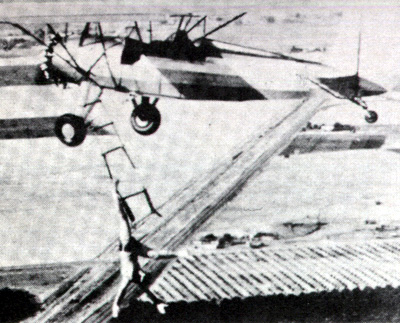
Cliff Winters hanging by a ladder.
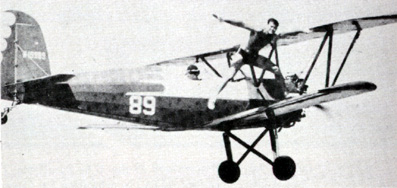
Cliff Winters wing walking in a bathing suit.
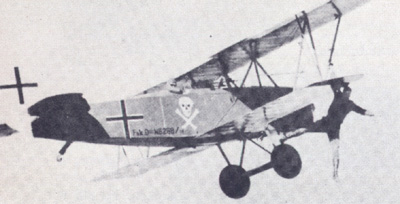
Cliff Winters hanging by one hand from a Fokker D VII.
Stunts
Winters worked on the mid-air transfer of the Ripcord television series. The scene was that the hero stepped from the first plane onto the tail of the bad-guy's plane. The hero was to climb forward and do bad stuff to the bad-guy. Lyle Cameron, playing the hero, was the person transferring planes, Winters flew the plane that Cameron started in. Cameron made the plane transfer fine and was about to move forward. Just then, the pilot of the second plane pulled up and knocked the wing off the plane Winters was flying.
At first Winters did not realize what had happened. Eventually, he knew something was wrong. He knew he had to bailout. The problem was that his parachute was not on him. Before the stunt, he did put it on, but Cameron joked, "What's the matter, don't you think we're gonna make it?" So Winters took the parachute off and put it in the back of the plane.
Winters managed to level the plane out around five thousand feet, but it promptly stalled. He climbed to the back to find the parachute. The plane was severely tumbling and spinning. The parachute had fallen off the seat, slid across the floor and, fortunately for Winters, had caught on the lip of the bottom door frame. The parachute would have fallen out during all the aerobatic maneuvers done during the stunt and subsequent uncontrolled flight.
Winters found the parachute, jumped and put the rig on in freefall. He pulled around one thousand feet. This was about where Cameron was under canopy. He fell off the second plane when it pulled up. The other pilot also bailed out. No lives were lost - just two planes.
Plane Crashes
Winters deliberately crashed planes into buildings as stunts for the movies. At the 1962 Chino Air Show he made a crash into a mock building. He noticed that cut the power a bit too late and the plane bounced off the ground after crashing into the building. The prop was sheared off by the building. The plane inverted at about 50-75 feet and landed upside down.
He recovered and did more building crashes. He placed a log across the front of the building. This would chop off the gear as it entered the building and avoid the bouncing plane problem. His plane crashes were now much safer. He powered down sooner and had the gear clipped by the log. The plane skidded to a stop on its belly on the other side of the building.
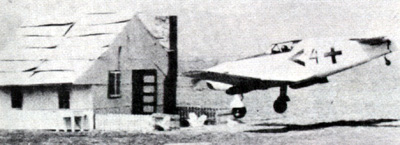
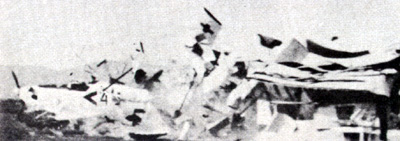
Before and after pictures of a plane crash.
Straight Jacket Jumps
Cliff Winters did several jumps with a straight jacket. He had a wooden ball-ripcord that he pulled with his teeth. He wanted to have a hidden palm release inside the straight jacket, but did not have time to rig that up. Winters jumped without it.
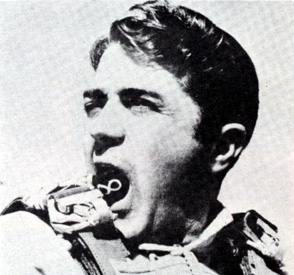
Cliff Winters gripping his ball-ripcord. The ball is painted as an 8-ball.
His second straight jacket jump was nearly his last jump. He had the straight jacket put on him, and then his main was strapped onto him. No reserve was used - as there was no way for him to pull it. He went to altitude and tumbled out of the airplane. He lost his tooth-hold on the ball - ripcord sometime during the tumbling. The ball - ripcord was attached to the right side of the harness near his shoulder. During all of his tumbling the harness started to fall off his shoulder. This meant the ball - ripcord was out of reach of his mouth. He tumbled and flailed, restricted by the straight jacket - trying to get the harness back on his shoulder. He finally succeeded and caught the ball-ripcord in his mouth. He pulled and landed safely.
Winters learned a lesson from that experience. He added an additional shoulder strap to his rig, so it would not fall off his shoulder.
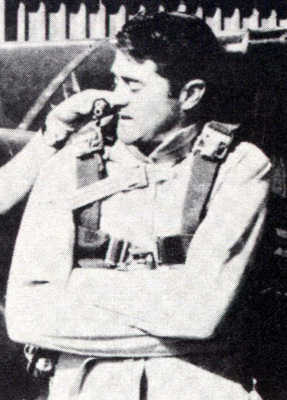
Straight-jacket gear with extra strap near shoulders.
Winters life ended at the 1963 Labor Day Air Show at Chino, CA. Winters snap rolled a special Ryan with a double wing into the ground and was killed.
"He was a really great stuntman" - Lyle Cameron Sr.
Photos from Sky Diver magazine.
[Products] | [Services]
[Join Our Mailing List] | [Advertise on ParachuteHistory.com]
[ ]
[Disclaimer] | [Privacy Policy] | [About]